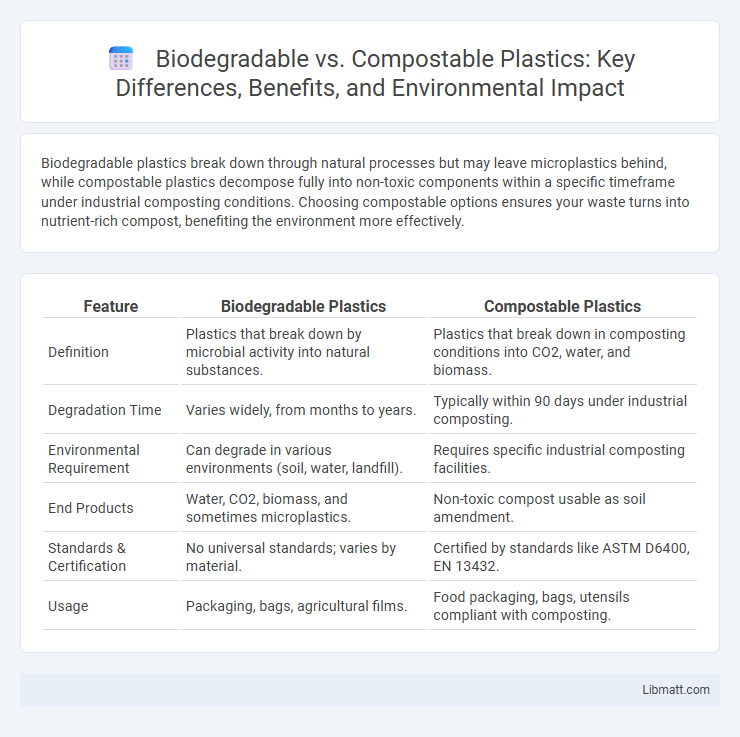Biodegradable plastics break down through natural processes but may leave microplastics behind, while compostable plastics decompose fully into non-toxic components within a specific timeframe under industrial composting conditions. Choosing compostable options ensures your waste turns into nutrient-rich compost, benefiting the environment more effectively.
Table of Comparison
| Feature | Biodegradable Plastics | Compostable Plastics |
|---|---|---|
| Definition | Plastics that break down by microbial activity into natural substances. | Plastics that break down in composting conditions into CO2, water, and biomass. |
| Degradation Time | Varies widely, from months to years. | Typically within 90 days under industrial composting. |
| Environmental Requirement | Can degrade in various environments (soil, water, landfill). | Requires specific industrial composting facilities. |
| End Products | Water, CO2, biomass, and sometimes microplastics. | Non-toxic compost usable as soil amendment. |
| Standards & Certification | No universal standards; varies by material. | Certified by standards like ASTM D6400, EN 13432. |
| Usage | Packaging, bags, agricultural films. | Food packaging, bags, utensils compliant with composting. |
Introduction to Biodegradable and Compostable Plastics
Biodegradable plastics break down into natural elements through microbial activity over time, but the process duration and environmental conditions vary widely. Compostable plastics decompose at a faster rate under industrial composting conditions, turning into nutrient-rich organic matter without leaving toxic residues. Understanding these distinctions helps you choose sustainable materials that align with your environmental goals.
Defining Biodegradable Plastics
Biodegradable plastics are materials designed to break down through the action of naturally occurring microorganisms such as bacteria and fungi, eventually converting into water, carbon dioxide, and biomass under specific environmental conditions. These plastics may derive from renewable resources or conventional petrochemicals but require certain temperature, moisture, and oxygen levels to degrade effectively. The rate and completeness of biodegradation depend on factors like polymer composition, environmental exposure, and the presence of suitable microbial populations.
Understanding Compostable Plastics
Compostable plastics break down into non-toxic components within a specific timeframe under industrial composting conditions, typically within 90 to 180 days. These plastics are certified by standards such as ASTM D6400 or EN 13432, ensuring they decompose without leaving harmful residues. Unlike biodegradable plastics, compostable plastics contribute to nutrient-rich compost, supporting sustainable waste management and soil health.
Key Differences Between Biodegradable and Compostable Plastics
Biodegradable plastics decompose through natural processes into natural elements over time, but the rate and conditions of degradation vary widely. Compostable plastics break down into non-toxic, nutrient-rich compost under specific industrial composting conditions within a defined timeframe, typically around 90 days. Unlike biodegradable plastics, compostable plastics must meet established standards such as ASTM D6400 or EN 13432 to ensure complete and safe decomposition without leaving harmful residues.
Environmental Impact Comparison
Biodegradable plastics break down into natural elements over time but may leave microplastic residues, whereas compostable plastics degrade completely into non-toxic components in industrial composting environments. Compostable plastics require specific conditions such as temperature, humidity, and microbial activity, limiting their environmental effectiveness if improperly disposed. Lifecycle analyses reveal that compostable plastics generally have a lower environmental impact due to their complete mineralization and reduced contribution to persistent plastic pollution compared to conventional biodegradable plastics.
Certification and Labeling Standards
Certification and labeling standards for biodegradable and compostable plastics vary significantly to ensure environmental claims are accurate and verifiable. Key certifications include ASTM D6400 and EN 13432, which specify requirements for industrial compostability, while labels like the Biodegradable Products Institute (BPI) provide third-party verification. Clear labeling helps consumers distinguish certified products, promoting proper disposal and reducing environmental impact.
Common Uses and Applications
Biodegradable plastics are commonly used in packaging, agricultural films, and disposable cutlery, providing an eco-friendly alternative to traditional plastics by breaking down under natural conditions. Compostable plastics find their primary applications in food service items, such as plates, cups, and bags, as they decompose fully within commercial composting facilities, enriching soil without leaving toxic residues. Understanding the specific requirements of your product's end-of-life process helps ensure the right choice between biodegradable and compostable plastics for sustainable use.
Challenges in Disposal and Recycling
Biodegradable plastics often require specific environmental conditions such as industrial composting facilities to break down effectively, making their disposal challenging in conventional waste systems. Compostable plastics, certified to disintegrate within a set timeframe under controlled conditions, can contaminate recycling streams if not properly separated, complicating waste management processes. Both types face significant hurdles in infrastructure availability and public awareness, limiting their potential benefits in reducing plastic pollution.
Consumer Awareness and Misconceptions
Consumer awareness of biodegradable vs. compostable plastics remains limited, leading to widespread misconceptions about their environmental impact and disposal methods. Many people mistakenly believe biodegradable plastics will break down quickly in any environment, while compostable plastics require specific industrial composting conditions to decompose properly. Understanding these differences enables you to make informed choices that reduce plastic pollution and support effective waste management practices.
Future Trends in Sustainable Plastics
Emerging future trends in sustainable plastics emphasize the development of advanced biodegradable and compostable materials derived from renewable resources, aiming to reduce environmental impact and reliance on fossil fuels. Innovations in enzymatic and microbial degradation technologies are accelerating the breakdown process, making these plastics more efficient in real-world composting conditions. Your choice of sustainable plastics supports the shift toward circular economy models, where waste is minimized, and material lifecycle is optimized for environmental health.
Biodegradable vs Compostable Plastics Infographic

 libmatt.com
libmatt.com